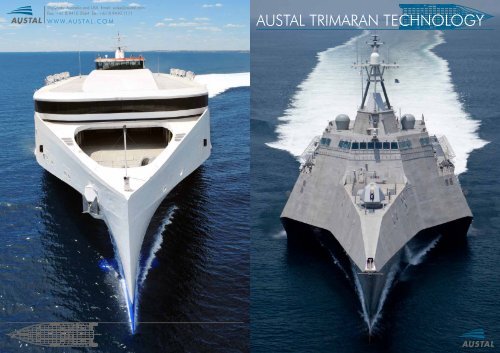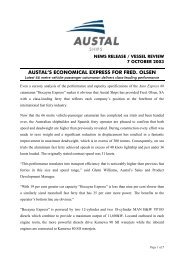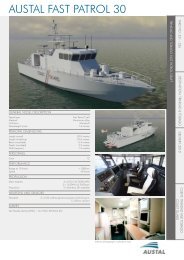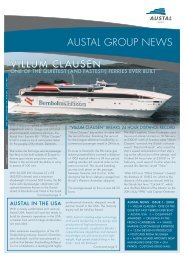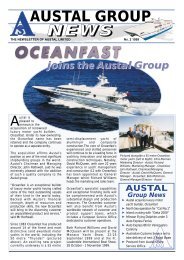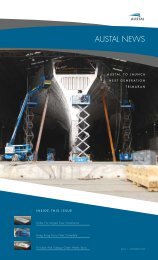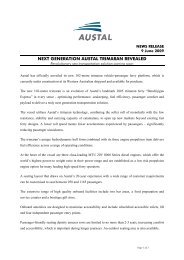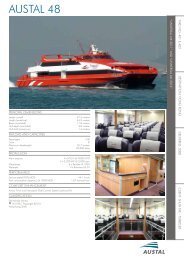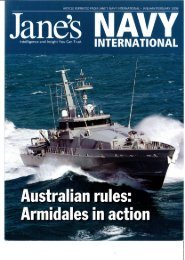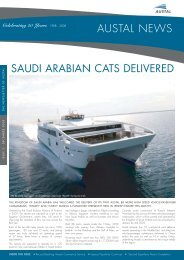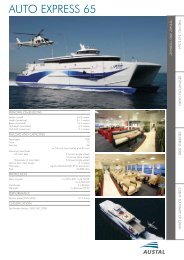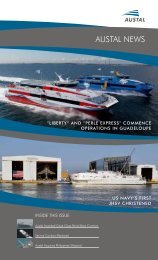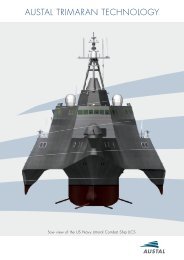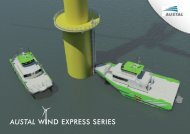Vessel Review - Austal Ships
Vessel Review - Austal Ships
Vessel Review - Austal Ships
Create successful ePaper yourself
Turn your PDF publications into a flip-book with our unique Google optimized e-Paper software.
Shipyards: Australia and USA Email: sales@austal.com<br />
Fax: +61 8 9410 2564 Tel: +61 8 9410 1111<br />
W W W. A U S TA L . C O M<br />
<strong>Austal</strong> Trimaran Technology
The trimaran advantage<br />
Design flexibility, fuel efficiency, unrivalled operability, improved passenger comfort. These are just some of the proven<br />
advantages of <strong>Austal</strong>’s patented trimaran technology.<br />
Most traditional high speed craft are either catamaran (two-hulls) or monohull (one hull) designs. <strong>Austal</strong>’s unique trimaran<br />
design consists of three hulls – one long slender middle hull and two side supporting hulls.<br />
This unique three-hulled arrangement combines the softer roll of monohulls with the low resistance, stability and carrying<br />
capacity of catamarans to deliver performance beyond that of traditional high speed craft.<br />
Proven in both commercial and defence operation, the trimaran’s slower roll means lower accelerations experienced by<br />
passengers and crew – significantly reducing seasickness.<br />
Compared to other high speed craft, the trimaran offers;<br />
• Greater speed for the same installed power<br />
• Improved fuel consumption when operating at the same speeds<br />
• GREATER comfort when operating in the same sea conditions (less seasickness)<br />
• Ability to operate in higher wave heights<br />
• Ability to maintain higher speeds in waves<br />
• Reduced incidence of tunnel slamming<br />
• Reduced waves created behind the vessel which reduces impact on the environment<br />
Roll Roll (deg) (deg)<br />
3.00<br />
2.50<br />
2.00<br />
1.50<br />
1.00<br />
0.50<br />
36% Reduction in Roll<br />
(Average for Beam Seas)<br />
100m Trimaran<br />
100m Catamaran<br />
Motion Motion Sickness Sickness Incidence Incidence<br />
40.0%<br />
35.0%<br />
30.0%<br />
25.0%<br />
20.0%<br />
15.0%<br />
10.0%<br />
5.0%<br />
56% Reduction in Motion Sickness<br />
(Average for Head Seas)<br />
100m Trimaran<br />
100m Catamaran<br />
<strong>Austal</strong> utilises advanced computer software and tank testing facilities<br />
0.00<br />
1 2 3 4 5 6 7 8 9 10 11 12 13 14 15<br />
Zero Zero Crossing crossing Period period Tz(s) Tz(s)<br />
0.0%<br />
1 2 3 4 5 6 7 8 9 10 11 12 13 14 15<br />
Zero Zero Crossing crossing Period period Tz(s) Tz(s)<br />
*Note: All seakeeping data for vessels with 340 tonnes deadweight @ 37 knots in 2.5 metre seas (significant wave height).<br />
Dependable - Developed, designed and built by the experts<br />
Low operating costs - Burn less fuel than alternative hullforms<br />
better Service Reliability - More operating days and fewer delays<br />
meeting your needs - suitable for a range of vessel sizes and types<br />
New opportunities - Operate when and where other fast ships cannot<br />
Fewer compromises - enhanced seakeeping no longer depends on size<br />
Greater Passenger and Crew Appeal - A more Comfortable ride, more often<br />
The discerning choice - chosen by leading commercial and defence operators
The Proven Solution<br />
Successfully proven in commercial operation for over half a decade and now chosen by the US Navy to form part of its next<br />
generation fleet, the <strong>Austal</strong> trimaran hull form offers proven benefits.<br />
The original <strong>Austal</strong> trimaran resulted from a three-year research and development program to create a new hullform to<br />
revolutionise the performance and operability of large high speed craft.<br />
Since her delivery in 2005, <strong>Austal</strong>’s inaugural 127 metre trimaran vehicle ferry “Benchijigua Express” has continued to highlight<br />
the advantages of trimaran technology to commercial operations. Despite operating along the roughest of the Canary Islands<br />
routes, “Benchijigua Express” has proven her ability to deliver passengers to their destination in comfort whatever the weather.<br />
Sea keeping has been called the forgotten factor in the fast ferry market. Routes being considered for fast ferries today are<br />
typically longer and more exposed than the routes of yesterday.<br />
Dedicated Research and Development team.<br />
127 metre trimaran, “Benchijigua Express” in operation in the Canary Islands. Image courtesy of Fred.Olsen, S.A.<br />
The expectations of comfort demanded by passengers are higher today than a few years ago. Ferries that are comfortable<br />
and seaworthy attract loyalty from the passengers who are also looking for a super ferry feel on fast ferries. Competition from<br />
short haul cut price airlines has further increased the pressure on the ferry market share.<br />
Over the last decade, builders of fast ferries have supplied larger and larger vessels with more deadweight carrying capacity,<br />
A secondary effect of the increase in size has been the improvement in the vessel’s sea keeping ability. However this has<br />
occurred as a consequence of the development and has not been its prime objective.<br />
The trimaran hull form allows <strong>Austal</strong> to decouple capacity from the length and sea keeping of the vessel. This is an important<br />
characteristic for operators who have a rough sea route and a low deadweight requirement.<br />
102 metre trimaran under construction. 127 metre Littoral Combat Ship “Independence” preparing for launch.
Next Generation 102 Trimaran<br />
Taking trimaran technology to a new level, <strong>Austal</strong>’s next generation 102 metre trimaran offers additional innovations and<br />
improvements, particularly with regards to passenger comfort. Building on the success of <strong>Austal</strong>’s previous trimarans, the 102<br />
metre design improves seakeeping, fuel efficiency, passenger comfort and operational reliability.<br />
As well as maximising efficiency, the unique hydrodynamic hull form and three engine propulsion train deliver a speed of 39<br />
knots (at 90% MCR) with 340 tonnes deadweight.<br />
102 m Principal particulars<br />
Length overall:...................................102.0 m<br />
Beam (moulded):.................................27.4 m<br />
Hull draft (maximum):.............................4.5 m<br />
Passengers:....................... 1,165 in 3 lounges<br />
Cars:..........................254 (4.5 x 2.35 metres)<br />
Truck lane metres:................188 plus 145 cars<br />
Trucks:.................. 12 tonne double wheel axle<br />
................................9 tonne single wheel axle<br />
Speed:...........................................39.0 knots<br />
(90% MCR, 340 tonnes deadweight)<br />
“Many concepts which have been very promising in calm water and low sea states<br />
have encountered considerable problems in higher waves.<br />
MARINTEK has over the last 20 years tested more than 200 different high speed<br />
craft concepts for customers around the world, including monohulls, catamarans,<br />
multihulls, Surface Effect <strong>Ships</strong> and foil assisted vehicles...The <strong>Austal</strong> trimaran<br />
is the most advanced high speed concept we have been involved in regarding<br />
speed, size and rough weather behaviours.”<br />
MARINTEK, Norway
Benchijigua Express<br />
The most significant vessel to arrive on the fast ferry market in recent years, “Benchijigua Express” was delivered in 2005 to<br />
Spanish ferry operator Fred Olsen, S.A and continues to successfully service the Canary Islands.<br />
<strong>Austal</strong>’s inaugural trimaran has earned a reputation for its ability to deliver passengers to their destination in comfort whatever<br />
the weather. With a roll motion more akin to a large conventional steel ferry, the vessel has introduced new levels of passenger<br />
comfort along a route known for its challenging conditions.<br />
Benchijigua EXPRESS Principal particulars<br />
Length overall:..........................................126.7 m<br />
Beam (moulded):........................................30.4 m<br />
Hull draft (approx.):.......................................4.2 m<br />
Passengers:..................................................1,291<br />
Vehicles:...................................................341 cars<br />
Heavy vehicles:.....450 truck lane metres & 123 cars<br />
Speed (100% MCR):.............................. 40.5 knots<br />
“(The vessel) Will improve overall efficiency in terms of passenger capacity,<br />
deadweight and freight lane metres by more than 35%. At the same time passenger<br />
comfort will increase by 25% to 40% depending on the routes we operate.<br />
This trimaran should, for us, be the solution for many years to come and could<br />
very well set the standard for a new generation of large fast ferries. We believe our<br />
customers deserve the best. “<br />
Fred Olsen, S.A.
Littoral Combat Ship (LCS)<br />
Delivered to the US Navy in 2009, the 127 metre <strong>Austal</strong>-designed and built Littoral Combat Ship (LCS) “USS Independence”<br />
is a new breed of surface combatant.<br />
With its proven trimaran hull form, the vessel offers superior sea keeping, manoeuvrability and endurance to travel 4,300 miles<br />
at 18 knots. The vessel also boasts three mission module zones, the capacity to carry any two mission modules simultaneously,<br />
and a flight deck larger than any other surface combatant.<br />
LCS Principal particulars<br />
Length:.......................................... 127 m<br />
Beam:.......................................... 31.4 m<br />
Hull draft (max):.............................. 4.5 m<br />
Mission bay:............................. 11,000 m<br />
Speed:....................................... 40 knots<br />
Range:..................................... 3,500 nm<br />
Crew:................................................. 40<br />
Aviation:..............2 x SH-60 or 1 x CH-53<br />
“LCS will have the capability to secure the littoral regions upon which communities<br />
rely on for food, transportation and for their well-being, and to protect critical<br />
chokepoints in the global supply chain, to launch unmanned air, underwater and<br />
surface vehicles that will keep our trade at sea and our men and women ashore<br />
safe from harm.”<br />
ADM Gary Roughead, Chief of USA Naval Operations<br />
Mission Configurations<br />
Anti-mine warfare (MIW)<br />
Anti-submarine warfare (ASW)<br />
Surface warfare (SUW)<br />
Future mission capabilities<br />
Special operations (Spec Ops)<br />
Intelligence, surveillance & reconnaissance (ISR)<br />
Humanitarian assistance / disaster relief (HA/DR)


